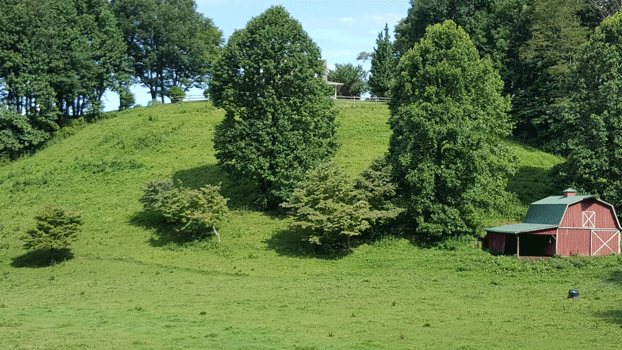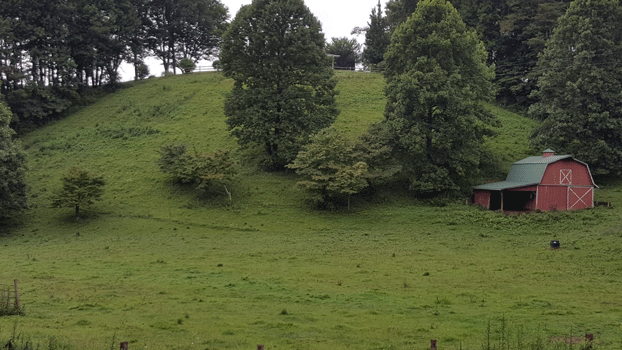Welcome back to another fall leaf color season! It’s been somewhat of a rough going these past two years, but hopefully things will turn around this year. So far, the weather is cooperating. We haven’t had extremely high temperatures, nor any serious droughts in the mountains. The latest climate report for NC is posted below from the NC Climate Office: (http://climate.ncsu.edu/climateblog?id=262&h=a71a1169).
I haven’t seen any signs of major diseases on trees, although this year the tent caterpillars are having quite a show, mainly on black cherry trees. You may have noticed their webs at the ends of branches. Some trees can get quite infested and they will devour the leaves. So those trees won’t be showing much this year. Black locusts are turning their usual brown now, due to a native leaf mining insect, but they always come back year after year, no harm done.
A few trees have already started to turn color, but don’t panic – these are sports that always turn early each year. I include some photos of them. I have no good idea why they turn so early each year. They are simply weird trees.
The majority of trees in the woods haven’t done much turning yet – a few tulip poplars are dropping their older leaves here and there, but nothing major. And I haven’t noticed the leaf weevil on them this year, which did a number on them near Asheville a few years ago. However, flowering dogwoods are definitely beginning to color up (see attached photos). This species will begin to slowly turn their usual deep burgundy red, even in August, but the colors develop slowly, and build up all the way into October. It has one of the more extended leaf coloring periods of any of our native species.
People always ask if summer weather has any effects on the timing or quality of fall leaf color. In a nutshell, it does not, severe drought not included. But the weather in mid- to late August and through September is critical. Overly warm temperatures in August, and particularly in September, will delay colors by a several days, and reduce the intensity of the color of red leaves. It may also disrupt the fall leaf color synchrony, with some species turning at their normal time (such as sourwoods) while others, such as red maples, delaying their colors until temperatures cool down again. This tends to reduce the visual quality of the fall leaf color experience because by the time the delayed species color up, the early ones have already dropped their leaves. It’s always best when all the species color up at near the same time.
The other weather factors that can affect fall leaf colors are precipitation and cloudiness. If both occur with regularity in September they will dull the redder colors. The best conditions for red coloration are sunny, cool (but not freezing) days, and cold nights (again not below freezing). If we get those weather conditions in September, then we will be in for a good show. But clouds hold in the heat at night while during the day they lower the light intensity, resulting in less photosynthesis. Trees need the sunlight to manufacture anthocyanins, the pigment that gives leaves their red coloration.
Lastly, if we have a wind storm near or at the peak of fall leaf color, it can take down a large number of the leaves, reducing the length of the fall color season. This has happened on and off over the years, but luckily, such events are not too common.
All in all, at this early point in the season, I am predicting a good fall leaf color year. The long range NOAA forecast suggests we could be in for above normal temperatures, so that could delay the onset a few days. But precipitation is forecast to be near normal, so perhaps we won’t get too many clouds. I’d prefer it if we would cool down more so than we’ve been doing in recent years, so we get those intense colors.
If you are contemplating a fall leaf color trip, I suggest you make reservations right away, as hotels book up quickly. It is the busiest tourist season of the year in the NC Mountains, with a dollar input to the local economy in the range of $600 - $800 M from September through November. So not only is it our prettiest season, it is also crucial for supporting our merchants at this time of year, and contributing to the overall growth on the North Carolina economy.
There are plenty of websites devoted to fall leaf color, and I list a few here:
Asheville Tourism Office: https://www.exploreasheville.com/trip-ideas/seasonal-fun/fall/
Romantic Asheville: https://www.romanticasheville.com/fall.htm
Fall Leaf Color Maps: https://weather.com/maps/fall-foliage
Blue Ridge Mountain Life: https://blueridgemountainlife.com/fall-foliage/
Fall Color Map for NC: https://biology.appstate.edu/fall-colors/fall-color-map-north-carolina
Fall Colors in the Smokies: https://www.nps.gov/grsm/planyourvisit/fallcolor.htm
Christopher Place (tips on Smokies): https://www.christopherplace.com/5-tips-for-planning-to-see-the-smoky-mountain-fall-colors/
Watauga Democrate Site (not yet updated for 2018): http://wataugaonline.com/fall-color-report/
Blue Ridge Parkway: https://www.blueridgeparkway.org/fall-color-on-the-parkway/
Sites to See in NC: https://www.tripstodiscover.com/best-places-to-see-fall-foliage-in-north-carolina/
So, get ready! Fall will be here before you know it! Let’s hope it’s a banner year for fall leaf colors! Ciao!

Flowering dogwoods and tulip poplars near Boone on 8/1/18

Photo of flowering dogwoods and tulip poplars near Boone on 8/4/18. Not the slight increase in reddish coloration by this date on the dogwoods.